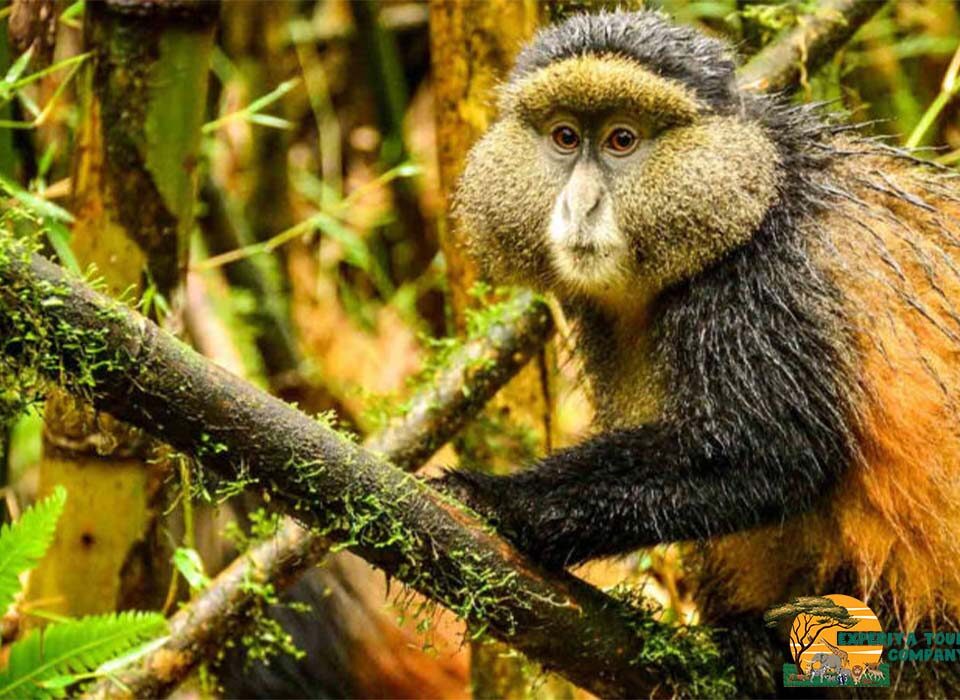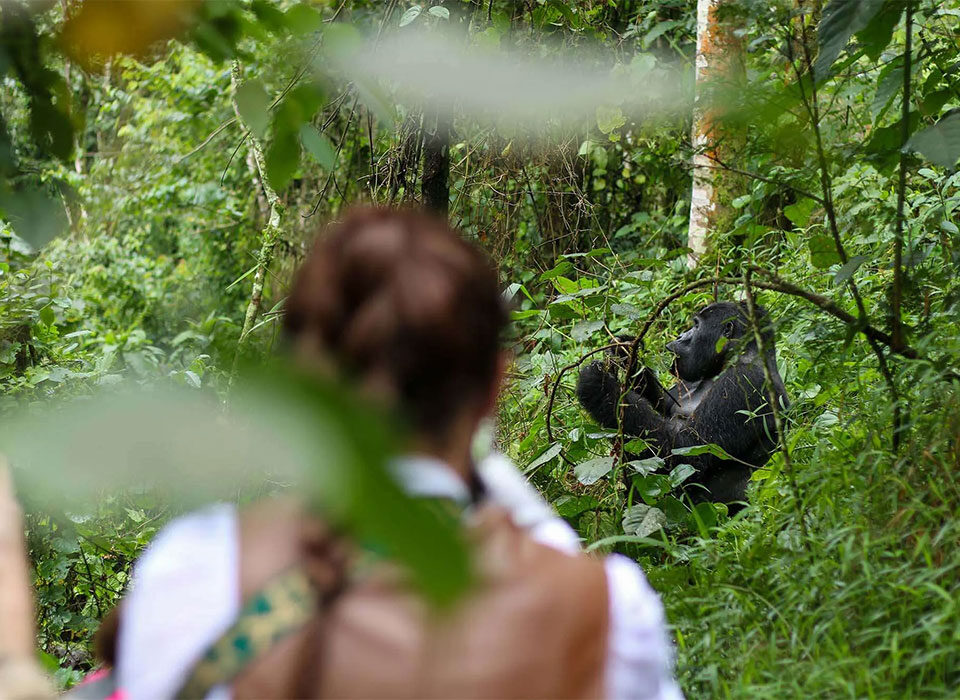
Which Park in Uganda Offers the Best Scenery? | Uganda Safari Guide
October 24, 2025
What’s the Difference Between Kibale and Budongo Forests? | Uganda Safari Guide
October 24, 2025Where Can I Track Chimpanzees in Uganda? | Uganda Safari Guide

Where Can I Track Chimpanzees in Uganda?
Uganda, known as the “Pearl of Africa,” is a country of stunning diversity — a land where mountain gorillas dwell in misty rainforests, lions roam golden savannahs, and chimpanzees swing effortlessly through ancient trees. While most travelers visit Uganda for its famous gorilla trekking adventures, those who venture beyond soon discover another equally fascinating experience: chimpanzee tracking.
Chimpanzees, our closest living relatives, share nearly 98% of our DNA. Observing them in their natural habitat is one of the most emotionally moving and intellectually engaging wildlife encounters in Africa. They display complex social behaviors — grooming, playing, arguing, and even using tools — all of which mirror our own human nature in striking ways.
Uganda is one of the best places in the world to see chimpanzees in the wild. The country is home to over 5,000 chimpanzees, spread across several protected areas. Whether you want to join researchers for a full-day habituation experience or enjoy a classic two-hour forest trek, Uganda offers multiple destinations where you can track these incredible primates.
In this guide, we’ll explore the best places to track chimpanzees in Uganda, what to expect on your trek, and why this experience deserves a top spot on your safari itinerary.
Kibale National Park – The Primate Capital of the World
If there is one destination that stands above the rest for chimpanzee tracking in Uganda, it’s Kibale National Park. Often called the Primate Capital of the World, Kibale is home to over 1,500 chimpanzees and 12 other primate species, including red colobus monkeys, grey-cheeked mangabeys, and L’Hoest’s monkeys.
Located in western Uganda, near the town of Fort Portal, Kibale’s dense tropical rainforest offers one of Africa’s most reliable chimpanzee tracking experiences, with a success rate of over 95%.
Chimpanzee tracking in Kibale begins early in the morning with a briefing at Kanyanchu Visitor Centre. Afterward, visitors head into the forest in small groups, guided by Uganda Wildlife Authority (UWA) rangers who are experts at locating the chimps. The trek usually lasts between 2 and 4 hours, depending on where the chimps are that day. Along the way, you’ll walk through towering fig trees, tangled vines, and lush vegetation filled with birds and butterflies. Once you find the chimpanzees, you’re allowed to spend one hour observing them — a moment that feels both exhilarating and intimate.
The chimps may be feeding high in the trees, playing on the forest floor, or grooming one another in social clusters. Their sounds — from deep hoots to high-pitched screams — echo through the forest, creating an atmosphere that’s both wild and enchanting.
For travelers seeking a deeper experience, Kibale also offers the Chimpanzee Habituation Experience (CHEX). This full-day activity allows you to spend extended time with a semi-habituated chimpanzee group that is still getting used to human presence. You’ll follow them from early morning until they build their nests at dusk, gaining a unique insight into their daily lives.
Kibale stands out because it has the highest population of chimpanzees in Uganda, almost guaranteed sightings, and excellent birding and primate viewing opportunities.
Budongo Forest Reserve – The Hidden Gem Near Murchison Falls
Just south of Murchison Falls National Park lies Budongo Forest Reserve, another outstanding location for chimpanzee tracking in Uganda. It’s the country’s largest mahogany forest, part of the greater Murchison Falls Conservation Area, and home to around 800 chimpanzees. The most popular section for tracking is Kaniyo Pabidi, where one chimpanzee community of about 100 individuals has been habituated for tourism and research.
Tracking in Budongo offers a more serene and less crowded experience compared to Kibale. The forest trails are wide and gently sloping, making it one of the easier treks for travelers of all fitness levels. Your adventure begins with a morning briefing, followed by a guided walk through towering mahogany and ironwood trees. The forest feels ancient and tranquil, with sunlight streaming through the canopy and the air filled with the songs of birds.
The guides in Budongo are experienced and highly knowledgeable, not just about chimpanzees but also about the forest’s ecology and birdlife. Once you locate the chimps, you’ll observe them feeding, grooming, and sometimes communicating with loud pant-hoots that reverberate through the trees.
Because Budongo is located near Murchison Falls, many travelers combine a chimpanzee trek here with a wildlife safari in the park — spotting elephants, giraffes, and lions by day, and chimps by morning.
Budongo is special because it’s quieter and less touristy than Kibale, has easy access from Murchison Falls, and is excellent for combining chimp trekking with big game drives.
Kyambura Gorge – The Valley of the Apes
Inside the scenic Queen Elizabeth National Park lies a hidden gem known as Kyambura Gorge — often referred to as the Valley of the Apes. This lush, forested canyon stretches about 16 kilometers long and drops over 100 meters deep into the surrounding savannah.
The gorge is one of Uganda’s most dramatic landscapes — a ribbon of green slicing through golden plains — and it provides a completely different chimpanzee tracking experience. Tracking in Kyambura Gorge is an adventure that combines stunning scenery with wildlife encounters. You’ll begin your trek at the gorge’s rim, descending along narrow trails into the forest below. The descent alone offers panoramic views of the valley and the distant Rwenzori Mountains.
Once inside, the air grows cooler, and the atmosphere becomes alive with the sounds of birds and rustling leaves. The chimpanzee population here is smaller — around 30 individuals — but sightings, while not guaranteed, are immensely rewarding. The gorge also shelters monkeys, baboons, and abundant birdlife.
Even if you don’t see chimpanzees, the trek itself is worth it for the breathtaking scenery and the thrill of exploring such a unique geological feature.
Kyambura Gorge is unique because it combines chimp tracking with spectacular scenery and is located within Queen Elizabeth National Park, making it perfect for combining with game drives.

Kalinzu Forest Reserve – Affordable and Accessible
Located just outside Queen Elizabeth National Park, Kalinzu Forest Reserve is another excellent and often overlooked chimpanzee tracking destination. The forest is home to about 320 chimpanzees, with roughly 70 habituated for visitors. Kalinzu’s proximity to Queen Elizabeth makes it an ideal alternative for travelers who want to see chimpanzees without the higher costs associated with Kibale.
The tracking experience in Kalinzu is well-organized by the National Forestry Authority (NFA). Guided walks begin early in the morning, and the trails are well-maintained and scenic, winding through both primary and secondary forest. Along the way, you might encounter other primates such as black-and-white colobus monkeys and red-tailed monkeys, as well as colorful butterflies and tropical birds.
Chimpanzee sightings here are frequent, as the guides have years of experience following their daily movements. Tracking in Kalinzu feels wild but peaceful, offering a perfect balance of adventure and relaxation.
Kalinzu is worth visiting because it has a high success rate for chimp sightings, cheaper permits than Kibale, and is located close to Queen Elizabeth National Park.
Toro-Semliki Wildlife Reserve – A Wild and Remote Experience
For those who crave a more off-the-beaten-path adventure, Toro-Semliki Wildlife Reserve in western Uganda is an exciting choice. It’s the country’s oldest protected area and lies in the Albertine Rift Valley, between the Rwenzori Mountains and Lake Albert.
The reserve’s chimpanzee population is smaller and less habituated than in Kibale or Budongo, but that’s part of its charm. Researchers have been studying the chimps here for years, and they’ve discovered fascinating adaptations — the chimps of Toro-Semliki are known to spend more time walking upright on two legs than any other population in Africa.
Tracking here offers a unique insight into chimpanzee behavior in a semi-arid environment, with scenic landscapes where rainforest meets savannah. It’s ideal for adventurous travelers who prefer remote and wild settings.
What to Expect During Chimpanzee Tracking
Chimpanzee tracking is typically a half-day activity that starts early in the morning or sometimes in the afternoon. After a briefing about safety and behavior, groups of up to eight visitors follow experienced guides into the forest. Once you find a troop, you’ll spend about one hour observing them — watching how they communicate, play, and feed. It’s a thrilling and educational experience that offers deep insight into primate behavior and evolution.
To prepare for your trek, wear comfortable hiking shoes, long pants, and a light rain jacket. Bring water, insect repellent, and a camera (without flash). Physical fitness helps, as the terrain can be hilly or muddy depending on the season.
Why Uganda Is Africa’s Best Chimpanzee Destination
Uganda’s diversity of habitats — from lowland forests to mountain rainforests — provides a range of chimpanzee tracking experiences unlike anywhere else in Africa. Each forest has its own personality and rhythm, from the dense greenery of Kibale to the scenic gorge of Kyambura and the quiet trails of Budongo. Moreover, Uganda’s chimpanzee tracking is part of a larger safari experience. Within one itinerary, you can track chimpanzees, trek with gorillas, and enjoy game drives featuring lions, elephants, and hippos — all without crossing a border.
Recommended Safari Operator: Experiya Tour Company
To make the most of your chimpanzee tracking experience, it’s best to travel with an experienced safari operator who knows Uganda’s forests and wildlife intimately. Experiya Tour Company is one of Uganda’s top safari providers, specializing in personalized tours that combine primate trekking, wildlife safaris, and cultural experiences. Their professional guides are skilled at tracking chimpanzees in multiple locations, ensuring you have the best possible chance of unforgettable encounters. Whether you want to explore Kibale’s rainforest, Budongo’s ancient trees, or Kyambura’s scenic gorge, Experiya handles all logistics — from permits and transport to lodging and expert guiding.
With Experiya Tour Company, you’ll experience chimpanzee tracking not just as a tourist, but as an explorer connecting deeply with nature and Uganda’s wild heart.



